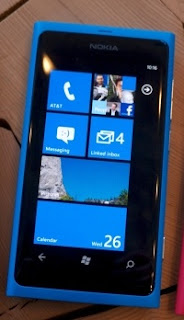In spite of some talk that Nokia would be permitted to modify the Windows Phone user interface, the Lumia 800 uses a totally unmodified interface. It’s fine around, but there's nothing to differentiate it in the competition. A push on the actual unlock button reveals the locking mechanism screen, which displays the present time and date and exhibits calendar events, emails and skipped calls.
Swiping the lockscreen up unlocks these devices and reveals the live-tile Metro interface. It's a very fluid up and down grid of Live tiles that shows a couple of tiles organized in bricked design. Each of these can be reorganized through which ever order you like and you will place almost anything in the actual grid by holding your hand over it and selecting the Pin to begin option.
It’s a clean as well as simple interface. The Live tiles show stuff like the current date, pending calendar occasions, missed calls, unread emails and much more, all without the need to open up the respective applications. You can take a look at them as homescreen widgets associated with sorts. But that’s oversimplifying all of them.
In Windows Phone Mango the actual Live tiles are quicker and gives more info. For example, the Pictures tile shows an animated slideshow of the images. The Group tile (Groups is really a Mango-only feature to boot) listings friend updates. The application list is continuing to grow a virtual Search button, making finding apps easier for individuals with many apps installed.
The Lumia 800 includes 7. 5 Mango and among its advantages over the unique version is multitasking. The OPERATING SYSTEM still doesn’t do true multitasking; things are now being done the iOS way. Apps not within the foreground are suspended, but the OS has methods to take over and carry out the duty for them.
To switch between apps you press and contain the Back key (that's correct, the Back key, not the actual Windows key). The app switcher itself looks much like that of Symbian or WebOS: thumbnail snapshots from the apps, ordered chronologically left in order to right.
You can scroll the list horizontally to pick an app and a tap brings you back to exactly the way you left it. Usually, the final 5-6 apps are here. You cannot "kill" any of those applications, this is more of a brief history of the recently used applications.
Eventually, as you open much more apps, the old ones start to drop from the list. Once an app is finished, you have to launch this again the old-fashioned way, which has the drawback of starting it over right from the start. Finally, apps with active history tasks (e. g. streaming online radio) could keep on working. Multitasking can be disabled in the settings to save on electric battery life. There you'll also find a summary of all installed apps that assistance multitasking.
Opening the settings menus reveals two sets of choices - system and applications. System covers all of the settings you can think associated with like sounds, color theme, Wi-Fi, Wireless bluetooth, Accounts, etc. The Applications settings allows you to configure individual settings for each app you've installed on the device - the folks hub, Phone, Maps and much more.
Windows Phone 7. 5 could be controlled through voice only - you are able to dictate a text, have the telephone read out the reply, you can initiate searches and so forth. Other OSes are doing this too (*cough*Android*cough*) but voice commands really are a big part of iOS (along with a loudly touted one at which), so WP7. 5 can brag about this too.






0 comments:
Post a Comment